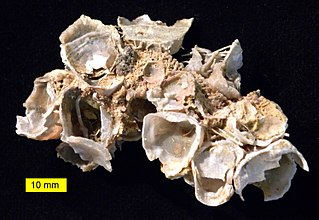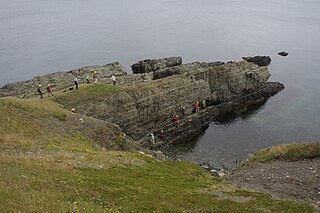Related Research Articles

The Cambrian is the first geological period of the Paleozoic Era, and of the Phanerozoic Eon. The Cambrian lasted 53.4 million years from the end of the preceding Ediacaran period 538.8 million years ago (mya) to the beginning of the Ordovician period 485.4 mya. Its subdivisions, and its base, are somewhat in flux.

A Global Boundary Stratotype Section and Point (GSSP) is an internationally agreed upon reference point on a stratigraphic section which defines the lower boundary of a stage on the geologic time scale. The effort to define GSSPs is conducted by the International Commission on Stratigraphy, a part of the International Union of Geological Sciences. Most, but not all, GSSPs are based on paleontological changes. Hence GSSPs are usually described in terms of transitions between different faunal stages, though far more faunal stages have been described than GSSPs. The GSSP definition effort commenced in 1977. As of 2023, 79 of the 101 stages that need a GSSP have a ratified GSSP.
The Tremadocian is the lowest stage of Ordovician. Together with the later Floian Stage it forms the Lower Ordovician Epoch. The Tremadocian lasted from 485.4 to 477.7 million years ago. The base of the Tremadocian is defined as the first appearance of the conodont species Iapetognathus fluctivagus at the Global Boundary Stratotype Section and Point (GSSP) section on Newfoundland.
The Furongian is the fourth and final epoch and series of the Cambrian. It lasted from 497 to 485.4 million years ago. It succeeds the Miaolingian series of the Cambrian and precedes the Lower Ordovician Tremadocian Stage. It is subdivided into three stages: the Paibian, Jiangshanian and the unnamed 10th stage of the Cambrian.
The Santonian is an age in the geologic timescale or a chronostratigraphic stage. It is a subdivision of the Late Cretaceous Epoch or Upper Cretaceous Series. It spans the time between 86.3 ± 0.7 mya and 83.6 ± 0.7 mya. The Santonian is preceded by the Coniacian and is followed by the Campanian.
In the geologic timescale, the Kimmeridgian is an age in the Late Jurassic Epoch and a stage in the Upper Jurassic Series. It spans the time between 154.8 ±0.8 Ma and 149.2 ±0.7 Ma. The Kimmeridgian follows the Oxfordian and precedes the Tithonian.
In the geologic timescale, the Sakmarian is an age or stage of the Permian period. It is a subdivision of the Cisuralian Epoch or Series. The Sakmarian lasted between 293.52 and 290.1 million years ago (Ma). It was preceded by the Asselian and followed by the Artinskian.

In the geologic timescale, the Roadian is an age or stage of the Permian. It is the earliest or lower of three subdivisions of the Guadalupian Epoch or Series. The Roadian lasted between 273.01 and 266.9 million years ago (Ma). It was preceded by the Kungurian and followed by the Wordian.
Lemdadella is an extinct genus of redlichiid trilobites that lived during the late Atdabanian stage, which lasted from 521 to 514 million years ago during the early part of the Cambrian Period.

The Terreneuvian is the lowermost and oldest series of the Cambrian geological system. Its base is defined by the first appearance datum of the trace fossil Treptichnus pedum around 538.8 million years ago. Its top is defined as the first appearance of trilobites in the stratigraphic record around 521 million years ago. This series' name was formally accepted by the International Commission on Stratigraphy in 2007.

The Fortunian age marks the beginning of the Phanerozoic Eon, the Paleozoic Era, and the Cambrian Period. It is the first of the two stages of the Terreneuvian series. Its base is defined as the first appearance of the trace fossil Treptichnus pedum 538.8 million years ago. The top of the Fortunian which is the base of the Stage 2 of the Cambrian has not been formally defined yet, but will correspond to the appearance of an Archeocyatha species or "Small shelly fossils" approximately 529 million years ago.
Stage 2 of the Cambrian is the unnamed upper stage of the Terreneuvian Series. It lies atop the Fortunian and below Stage 3 of the Cambrian. It is commonly referred to as the Tommotian, after the Cambrian stratigraphy of Siberia. Neither the upper nor lower boundary has yet been defined by the International Commission on Stratigraphy. The preferred definitions for the lower boundary are the first appearance of the molluscs Watsonella crosbyi or Aldanella attleborensis around 529 million years ago. The correlation between the lowest occurrences of A. attleborensis and W. crosbyi with the Zhujiaqing positive carbon isotope excursion (ZHUCE) has led to the conclusion that the combination of these two markers are a reliable indicator of the boundary between the Fortunian and Stage 2. The proposed upper boundary might be the first appearance of trilobites around 521 million years ago.
The Guzhangian is an uppermost stage of the Miaolingian Series of the Cambrian. It follows the Drumian Stage and precedes the Paibian Stage of the Furongian Series. The base is defined as the first appearance of the trilobite Lejopyge laevigata around 500.5 million years ago. The Guzhangian-Paibian boundary is marked by the first appearance of the trilobite Glyptagnostus reticulatus around 497 million years ago.
The Drumian is a stage of the Miaolingian Series of the Cambrian. It succeeds the Wuliuan and precedes the Guzhangian. The base is defined as the first appearance of the trilobite Ptychagnostus atavus around 504.5 million years ago. The top is defined as the first appearance of another trilobite Lejopyge laevigata around 500.5 million years ago.
The Wuliuan stage is the fifth stage of the Cambrian, and the first stage of the Miaolingian Series of the Cambrian. It was formally defined by the International Commission on Stratigraphy in 2018. Its base is defined by the first appearance of the trilobite species Oryctocephalus indicus; it ends with the beginning of the Drumian Stage, marked by the first appearance of the trilobite Ptychagnostus atavus around 504.5 million years ago.
Stage 10 of the Cambrian is the still unnamed third and final stage of the Furongian series. It follows the Jiangshanian and precedes the Ordovician Tremadocian Stage. The proposed lower boundary is the first appearance of the trilobite Lotagnostus americanus around 489.5 million years ago, but other fossils are also being discussed. The upper boundary is defined as the appearance of the conodont Iapetognathus fluctivagus which marks the beginning of the Tremadocian and is radiometrically dated as 485.4 million years ago.
The Miaolingian is the third Series of the Cambrian Period, and was formally named in 2018. It lasted from about 509 to 497 million years ago and is divided in ascending order into 3 stages: the Wuliuan, Drumian, and Guzhangian. The Miaolingian is preceded by the unnamed Cambrian Series 2 and succeeded by the Furongian series.
Cambrian Stage 4 is the still unnamed fourth stage of the Cambrian and the upper stage of Cambrian Series 2. It follows Cambrian Stage 3 and lies below the Wuliuan. The lower boundary has not been formally defined by the International Commission on Stratigraphy. One proposal is the first appearance of two trilobite genera, Olenellus or Redlichia. Another proposal is the first appearance of the trilobite species Arthricocephalus chauveaui. Both proposals will set the lower boundary close to 514 million years ago. The upper boundary corresponds to the beginning of the Wuliuan.
Cambrian Series 2 is the unnamed 2nd series of the Cambrian. It lies above the Terreneuvian series and below the Miaolingian. Series 2 has not been formally defined by the International Commission on Stratigraphy, lacking a precise lower boundary and subdivision into stages. The proposed lower boundary is the first appearance of trilobites which is estimated to be around 521 million years ago.
References
- Zhang (2017). "Challenges in defining the base of Cambrian Series 2 and Stage 3". Earth-Science Reviews. 172: 124–139. Bibcode:2017ESRv..172..124Z. doi:10.1016/j.earscirev.2017.07.017.
- ↑ "Chart/Time Scale". stratigraphy.org. International Commission on Stratigraphy.
- ↑ Ahlberg, Per; Babcock, Loren E. "Subcommission on Cambrian Stratigraphy Annual Report 2017" (PDF). International Commission on Stratigraphy. Archived (PDF) from the original on 2023-07-16. Retrieved 2024-03-27.
- ↑ "ISCS Working Groups: Working Group on the Stage 3 GSSP". International Subcommission on Cambrian Stratigraphy. Archived from the original on 2023-09-26.
- ↑ "GSSP Table - Paleozoic Era". Geologic Timescale Foundation. Archived from the original on 2023-10-08. Retrieved 2024-03-27.
- ↑ "The 13th International Field Conference of the Cambrian Stage Subdivision Working Group" (PDF). Episodes. 31 (4): 440–441. Archived from the original (PDF) on 2014-11-05. Retrieved 2024-03-27.
- ↑ Yuan, J.L.; Zhu, X.J.; Lin, J.P.; Zhu, M.Y. (22 September 2011). "Tentative correlation of Cambrian Series 2 between South China and other continents" (PDF). Bulletin of Geosciences: 397–404. doi: 10.3140/bull.geosci.1274 . Archived from the original (PDF) on 2024-01-18. Retrieved 2024-03-27.
- ↑ Degan Shu, Yukio Isozaki, Xingliang Zhang, Jan Han, Shigenori Maruyama (2014). "Birth and early evolution of metazoans". Gondwana Research . 25 (3): 884—895. doi:10.1016/j.gr.2013.09.001.
{{cite journal}}: CS1 maint: multiple names: authors list (link)